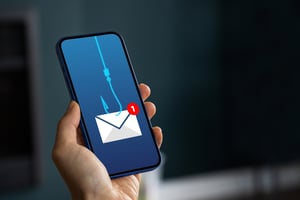The stakes for cybersecurity have never been higher in today's fast-evolving digital landscape....
Cybersecurity in 2025: AI, Automation and What Comes Next
Cybersecurity expert AJ Kotze of Techify shares practical, easy-to-understand insights on today’s biggest digital threats—and how every business, no matter its size or tech knowledge, can stay protected.
Cybersecurity in 2025
Cyber threats are evolving fast—and they’re no longer just a concern for IT departments.
In this candid interview, we sit down with AJ Kotze, a cybersecurity expert at Techify, to unpack what modern businesses need to know to stay protected. From common myths and real-world threats to AI-driven attacks and simple steps any team can take, AJ shares practical advice that’s easy to understand and act on.
Whether you're a business leader, marketer, or part of a non-technical team, this conversation will help you rethink your approach to cybersecurity.

Cybersecurity Interview with AJ
Interview below:
Anouk: Let’s start with the basics—what does cybersecurity mean in today’s digital world, and how has that definition evolved over the past few years?
AJ: It means that we are protecting against threats both internally and externally. Internal threats are often overlooked, since we trust our employees to do the right thing – but we don’t always tell them how to identify the right thing. Cybersecurity has evolved with technology, and as our technology has improved, so has the technology of those that wish us harm.
Anouk: What first drew you to cybersecurity, and what keeps you passionate about it?
AJ: My first investigation was in a previous employment. There was a mass exodus of people from a company, and they took proprietary and company secrets with them. We had an extensive forensics investigation and worked with a law agency to investigate the problem. I found it interesting how people tried to hide evidence – this is exactly what we are seeing today with cyber threats – threat actors can hide evidence that they are inside your environment, until they have found enough information to fool even your most technically sound staff.
Anouk: What are some of the most common misconceptions people have about cyber threats?
AJ:
- “It won’t happen to me” – It’s just a matter of time.
- “We are too small to be a target” – Smaller targets have smaller budgets and are more susceptible to attack.
- “Technical debt is not a problem” – Threat actors stay up to date on tech. If you haven’t been enhancing your security, you’re vulnerable.
Anouk: We often hear about “zero-day attacks” and “ransomware”—can you explain what these are in plain language and why they matter?
AJ:
- Zero-day means the vendor doesn’t even know about the vulnerability. We use automated solutions to detect these threats.
- Ransomware encrypts your system and holds your data ransom. Even with a decryption key, data loss is high. Early detection and automatic quarantine are essential.
Anouk: Can you share a recent cybersecurity trend or incident that really caught your attention? What can we learn from it?
AJ: Social engineering. I’ve seen “sleeper agents”—threat actors who compromise a user account and learn about the organization to deceive it. It’s hard to distinguish them from real employees.
Anouk: How do you see cyber threats evolving in the next 2–3 years, especially with AI and automation in the mix?
AJ: I’m horrified. Bots now do the work of an army of threat actors. AI uses your processes and personal knowledge against you. Companies must implement AI security solutions or risk extinction.
Anouk: What are three simple things every organization should be doing right now to improve their cybersecurity posture?
AJ:
- End-user training and phishing simulations.
- Use tools like DarkWebID and Phin Security.
- Hold team members accountable for training and simulated link clicks.
Anouk: How can non-technical teams contribute to a company’s cybersecurity efforts?
AJ:
- If you see something, say something—even if it’s a false alarm.
- Take training seriously and apply it daily.
- Leadership should ask IT about security posture and get third-party PEN testing.
Anouk: Cybersecurity can sound intimidating. How do you make it more accessible?
AJ: Make it part of company culture. Use short, animated, humorous training clips instead of boring lectures.
Anouk: What’s one myth about cybersecurity you wish you could bust forever?
AJ:
- Strong passwords aren’t enough if reused.
- Cybersecurity isn’t just IT’s job—it’s everyone’s.
- Antivirus alone isn’t sufficient—use layered security.
- Cybersecurity isn’t too expensive—neglect only what you can live without.
- Buying and self-implementing platforms isn’t enough—they must be set up properly.
Anouk: What’s one innovation in cybersecurity that excites you?
AJ: AI-driven automated response. Our systems can isolate infected devices at 3AM without human intervention.
Anouk: If you could give every business leader one piece of advice about cybersecurity, what would it be?
AJ: Don’t ignore it. Treat cybersecurity like physical security—lock the doors, activate alarms, and ensure insurance coverage.
Anouk: Biggest cybersecurity buzzword you wish would go away?
AJ:
- “Fear-based product”
- “100% secure / bulletproof”
- “Future proof” – These terms are overused and meaningless.
Anouk: Most underrated cybersecurity tool or practice?
AJ:
- Proactive approach—someone watching your back.
- SOC (Security Operations Centre)—like a bouncer at the door.
Anouk: One book, podcast, or resource you’d recommend?
AJ:
- Jonathan Edwards on YouTube (Microsoft 365)
- Darknet Diaries (true cybercrime stories)
- Cyberwire Daily (industry news and analysis)
End of interview.
Conclusion
Cybersecurity is no longer optional—and as AJ reminds us, it’s not just about firewalls and passwords. It’s about culture, awareness, and staying ahead of fast-moving threats.
If you're thinking about using AI in your business but feel overwhelmed or unsure where to start, you're not alone. At Techify, we help businesses harness AI safely and effectively, with solutions tailored to your goals and comfort level.
Ready to explore what AI can do for you? Let’s talk—we’ll guide you every step of the way.




